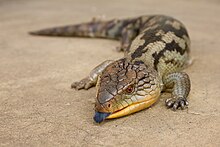Blue-tongued skink
| Blue-tongued skinks | |
|---|---|

| |
| Blotched blue-tongued skink (Tiliqua nigrolutea) | |
| Scientific classification | |
| Domain: | Eukaryota |
| Kingdom: | Animalia |
| Phylum: | Chordata |
| Class: | Reptilia |
| Order: | Squamata |
| Family: | Scincidae |
| Subfamily: | Egerniinae |
| Genus: | Tiliqua Gray,1825[1] |
| Species | |
|
8 extant, see text. | |
| Synonyms | |
|
Trachydosaurus | |
Blue-tongued skinks[2]comprise theAustralasiangenusTiliqua,which contains some of the largest members of theskinkfamily(Scincidae). They are commonly calledblue-tongued lizardsor simplyblue-tonguesorblueysinAustraliaorpananainIndonesia.As suggested by these common names, a prominent characteristic of the genus is a large blue tongue that can be bared asbluff-warningto potential enemies.[3]The type of predator/threat that is near will determine the intensity of colour present in the tongue. The tongue can also deform itself and produce a thickmucusin order to catch prey.[4]They are relatively shy in comparison with other lizards, and also significantly slower due to their shorter legs.
Systematics and distribution
[edit]Blue-tongued skinks are closely related to thegeneraCyclodomorphusandHemisphaeriodon.All species are found on mainlandAustraliawith the exception ofTiliqua gigas,which occurs inNew Guineaand various islands ofIndonesia.The Tanimbar blue-tongued skink, asubspeciesofTiliqua scincoides,is also found on several small Indonesian islands between Australia andNew Guinea.Tiliqua nigrolutea,the blotched blue-tongued skink, is the only species present inTasmania.
Ecology
[edit]Most species arediurnal,ground-foragingomnivores,feeding on a wide variety ofinsects,gastropods,flowers, fruits, and berries.[5]The pygmy blue-tongue is again the exception, being primarily anambush predatorofterrestrialarthropods.[6]
All areovoviviparous,with litter sizes ranging from 1-4 in the pygmy blue-tongue and shingleback to 5-24 in the eastern and northern blue-tongues.[7]
Species
[edit]| Name | Scientific Name | Picture | Subspecies |
|---|---|---|---|
| Adelaide pygmy blue-tongue skink | T. adelaidensis(Peters, 1863) | 
|
|
| No common name | †T. frangens[8] | 
|
|
| Indonesian blue-tongued skink | T. gigas(Schneider, 1801) | 
|
T. g. gigas,Giant blue-tongued skink;T. g. evanescens,Merauke blue-tongued skink;T. g. keyensis,Key Island blue-tongued skink |
| Centralian blue-tongued skink | T. multifasciata(Sternfeld, 1919) | 
|
|
| Blotched blue-tongued skink | T. nigrolutea(Quoy & Gaimard, 1824) | 
|
|
| Western blue-tongued skink | T. occipitalis(Peters, 1863) | 
|
|
| Shingleback, bobtail | T. rugosa
(Gray, 1825) |

|
T. r. aspera,Eastern shingleback;T. r. konowi,Rottnest Island bobtail;T. r. palarra,Shark Bay bobtail;T. r. rugosa,Common shingleback, bobtail |
| Common blue-tongued skink | T. scincoides(White, 1790) | 
|
T. s. chimaerea,Tanimbar blue-tongued skink;T. s. intermedia,Northern blue-tongued skink;T. s. scincoides,Eastern blue-tongued skink |
| Irian Jaya blue-tongued skink | Tiliquasp. | 
|
Extinct species
[edit]Multiple extinct species have been proposed.T. frangens,the largest known species of the genus, lived during thePlioceneandPleistoceneepoch around theWellington CavesofNew South WalesinAustralia.Another extinct speciesT. laticephalamay represent the same taxon asT. frangens.Its nearest relative is the extantT. rugosa,which is half the size and lacks the bony plates ofT. frangens.[9][10][11]
Another extinct speciesT. wilkinsonorumalso lived during thePlioceneepoch. The earliest possible species isT. pusillafrom the middleMiocene,but researchers question whether this species belong to the genusTiliquadue to its uncertain phylogenetic position that causesparaphyly.[9]
In captivity
[edit]Blue-tongued skink species are generally docile, gentle, quiet and easily tamed, and can make a good reptile pet for beginners. Although they are not aggressive, they have strong jaws and teeth, meaning that a bite from a skink can be painful. It is advisable not to startle or provoke them, as they may bite if they feel threatened.[12]Individuals can live up to 20 years or more.[13]
Notes
[edit]- ^Gray, J.E. (1825). A synopsis of the genera of reptiles and Amphibia, with a description of some new species.Annals of Philosophy10:193—217.p. 201
- ^Tiliqua,Reptile Database
- ^Abramjan, Andran (2015). "Why is the tongue of blue-tongued skinks blue? reflectance of lingual surface and its consequences for visual perception by conspecifics and Predators".The Science of Nature.102(7–8): 42.Bibcode:2015SciNa.102...42A.doi:10.1007/s00114-015-1293-4.PMID26185113.S2CID16915899.
- ^Tamara L. Smith; Kenneth V. Kardong; Vincent L. Bels (1999)."Prey Capture Behavior in the Blue-tongued Skink, Tiliqua scincoides"(PDF).Journal of Herpetology.33(3): 362–369.doi:10.2307/1565632.JSTOR1565632.Retrieved24 May2022.
- ^Cogger, H.G. (2000).Reptiles and Amphibians of Australia.Reed New Holland.
- ^Department for Environment and Heritage > Pygmy Bluetongue Lizard - fact sheet,Environment.sa.gov.au, retrieved 18 July 2017
- ^Turner, G. 2001. Keeping Bluetongue Lizards. Australian Reptile Keeper Publications.
- ^Thorn, Kailah M.; Fusco, Diana A.; Hutchinson, Mark N.; Gardner, Michael G.; Clayton, Jessica L.; Prideaux, Gavin J.; Lee, Michael S. Y. (2023-06-14)."A giant armoured skink from Australia expands lizard morphospace and the scope of the Pleistocene extinctions".Proceedings of the Royal Society B: Biological Sciences.290(2000).doi:10.1098/rspb.2023.0704.ISSN0962-8452.PMC10265006.PMID37312544.
- ^abThorn, K.M.; Fusco, D.A.; Hutchinson, M.N.; Gardner, M.G.; Clayton, J.L.; Prideaux, G.J.; Lee, M.S.Y. (2023)."A giant armoured skink from Australia expands lizard morphospace and the scope of the Pleistocene extinctions".Proceedings of the Royal Society of London B: Biological Sciences.290(2000). 20230704.doi:10.1098/rspb.2023.0704.ISSN1471-2954.PMC10265006.PMID37312544.S2CID259149033.Supplementary Information
- ^Extinct lizard was a bizarrely supersized version of modern skinks,Alice Klein,New Scientist,2023-06-14
- ^Meet the biggest and most bizarre skink ever found in Australia. It became extinct 47,000 years ago,2023-06-14
- ^"Feeding and Care of Your Blue-Tongued Skink".Thesprucepets.com.Retrieved24 May2022.
- ^"Blue-Tongued Skink - Tiliqua".Petmd.com.Retrieved24 May2022.
References
[edit]- Austin, J.J. & Arnold, E.N.(2006). Using ancient and recent DNA to explore relationships of extinct and endangeredLeiolopismaskinks (Reptilia: Scincidae) in the Mascarene islands.Molecular Phylogenetics and Evolution39(2): 503–511.doi:10.1016/j.ympev.2005.12.011(HTML abstract)
- Bull, C.M.(1988). Mate fidelity in an Australian lizardTrachydosaurus rugosus(Scincidae).Copeia1987(3): 749-757.
- Bull, C.M.(1990). Comparison of displaced and retained partners in a monogamous lizardTiliqua rugosa.Australian Wildlife Research17:135-140.
- Valentic, R.A.(1996). A prey record of the Eastern Blue-tongueTiliqua scincoidesfor the common brown snakePseudonaja textilis.Monitor8(3): 155.
